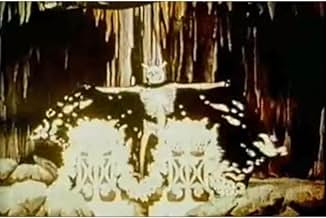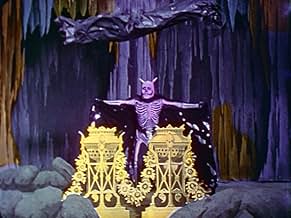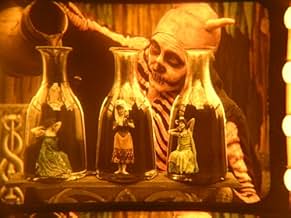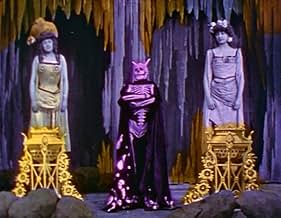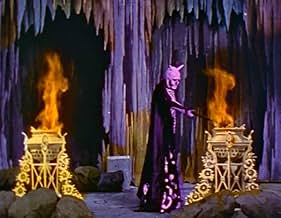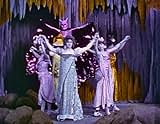IMDb-BEWERTUNG
6,5/10
1312
IHRE BEWERTUNG
Füge eine Handlung in deiner Sprache hinzuA demonic magician attempts to perform his act in a strange grotto, but is confronted by a Good Spirit who opposes him.A demonic magician attempts to perform his act in a strange grotto, but is confronted by a Good Spirit who opposes him.A demonic magician attempts to perform his act in a strange grotto, but is confronted by a Good Spirit who opposes him.
- Regie
- Drehbuch
- Hauptbesetzung
Empfohlene Bewertungen
In 1907, we all agree, cinema audiences could be easily amused, so to say. But even today, to look at the pioneering cinema ways used to trick the human mind is somewhat fascinating. I, myself, get more of a kick from watching these old fashioned movie magicians than in a live magic show where everything is overdone. Here, the camera is still, Satan is a guy in a Halloween costume - but see how the frame is used to its fullest, the sets are so creepy and the eerie atmosphere kicks off right away, when we see a twirling coffin magically appear, and the magic show begins.
A treat for all fans of novelty early cinema.
A treat for all fans of novelty early cinema.
Here's Segundo de Chomon challenging Melies as the master of the trick film, using the sort of magician's act that Melies did. It's a combination of stage magic and movie magic -- if you look carefully, you can see the moments when the camera stops and something is substituted.
Because whenever Melies got before the cameras and did his act -- he was a stage magician and had gotten into making movies to fill up the show at his Theatre Robert-Houdin -- you could see his pleasure in performing, there was no way that de Chomon could match that. So he stuck his unnamed performing in a skeleton costume with horns and a cape. It's so over-the-top that it's magnificent.
Because whenever Melies got before the cameras and did his act -- he was a stage magician and had gotten into making movies to fill up the show at his Theatre Robert-Houdin -- you could see his pleasure in performing, there was no way that de Chomon could match that. So he stuck his unnamed performing in a skeleton costume with horns and a cape. It's so over-the-top that it's magnificent.
Also, the story for this is somewhat confusing; if I hadn't seen the brief plot summary on Letterboxd, I wouldn't know (until near the end anyway) that this was about a Good Woman fighting the devil or a demon of hell or whoever this guy in a robe and skull-face is. It seemed if it was about a woman who might have even been this demon's boss, or maybe even some annoying underling, screwing with this Demon-Man has a penchant for bottling up women (literally, you can see this in full close-up, and that's how it seems - a full 8 years before Griffith did it in in Birth of a Nation you get a close-up, albeit in camera and with separate shots without a cut).
But at any rate, this is a fun short because the filmmaking is clever and inventive: we're seeing the process this devil takes with his female wares/prisoners, and it's through blazing red and orange colors (thanks silent film technology!) and with a magician's eye for trickery. By the end 'good' does prevail, but the joy is in the evil, if that makes sense; it's filmmakers reveling in the villainy of this Demon, or at least playing with the line between showing something as being *bad* as in a devil, or something that is... enjoyable to do, like, uh, bottling up women and making them prisoners. Or slaves. Or, I don't know what. This is simply cool, and it also empowers women to fight Satan's ways at the end of it all! How to do that, well, don't look at this for answers to that question, just watch magic tricks!
But at any rate, this is a fun short because the filmmaking is clever and inventive: we're seeing the process this devil takes with his female wares/prisoners, and it's through blazing red and orange colors (thanks silent film technology!) and with a magician's eye for trickery. By the end 'good' does prevail, but the joy is in the evil, if that makes sense; it's filmmakers reveling in the villainy of this Demon, or at least playing with the line between showing something as being *bad* as in a devil, or something that is... enjoyable to do, like, uh, bottling up women and making them prisoners. Or slaves. Or, I don't know what. This is simply cool, and it also empowers women to fight Satan's ways at the end of it all! How to do that, well, don't look at this for answers to that question, just watch magic tricks!
Director Segundo de Chomon's THE RED SPECTRE is a wonderful, subterranean magic show, put on by the skeletal entity of the title. It features various female subjects in various tricks and fantastical situations.
Mr. De Chomon once again shows his sense of humor, along with his love of the supernatural. The special effects are, as always, some of the best of the era. Of special interest are the women in the bottles, the flip-screen images, and the reverse-action wall-building sequences.
Horror fans should find this short film fascinating, since it is one of the vintage examples of what was yet to come...
Mr. De Chomon once again shows his sense of humor, along with his love of the supernatural. The special effects are, as always, some of the best of the era. Of special interest are the women in the bottles, the flip-screen images, and the reverse-action wall-building sequences.
Horror fans should find this short film fascinating, since it is one of the vintage examples of what was yet to come...
The first decade of the twentieth century saw the production of dozens of brief "trick films" which pushed the boundaries of the new medium, and France was the capital of this activity. Georges Méliès is the best known creator of these films, but The Red Spectre, which was produced at the Pathé Studio as a collaboration between Méliès' fellow pioneers Ferdinand Zecca and Segundo De Chomon, is perhaps the most bizarre and fascinating of them all. Or at least, allowing for the fact that so many of these films are lost, it certainly ranks with the best of the survivors. It is better seen than described, genuinely dreamlike in its images and transitions, and quite strange, but quite satisfying as well. The action lasts only about 8 or 9 minutes, but when it's over you feel as if you've been permitted to visit another world. When The Red Spectre was first exhibited the black & white footage was hand-colored to produce a dazzling effect, and happily, this material survives: a color print was discovered in a junk-yard in Mexico, and purchased for $25.00!
Our setting is a mysterious underground grotto, and our "host" is a demonic magician who seems to be toying with the souls or spirits of several captive women. He causes them to levitate, then burst into flames; he captures their ashes in bottles, brings them back to life in miniaturized form, etc. The magician is opposed throughout by a Good Fairy who resembles Peter Pan (portrayed by a woman, as Peter traditionally is on stage). The precise meaning of the action is difficult to determine at times, but the central conflict amounts to a struggle between the forces of Good and Evil.
One effect is especially notable: when the wicked magician produces three glass bottles, each holding a tiny woman prisoner, and brings them downstage to allow for a close-up, the scene instantly reminds latter day viewers of a similar sequence in The Bride of Frankenstein (1935). Did James Whale see this film, or is the similarity a coincidence? Notable, too, is the depiction of a device very much like television-- strongly suggested by the evil conjurer's magic screens, each of which depicts a series of moving images. Here's a real cinematic milestone: a film that predicts the coming of T.V., and, on top of that, attributes its invention to a demon!
Our setting is a mysterious underground grotto, and our "host" is a demonic magician who seems to be toying with the souls or spirits of several captive women. He causes them to levitate, then burst into flames; he captures their ashes in bottles, brings them back to life in miniaturized form, etc. The magician is opposed throughout by a Good Fairy who resembles Peter Pan (portrayed by a woman, as Peter traditionally is on stage). The precise meaning of the action is difficult to determine at times, but the central conflict amounts to a struggle between the forces of Good and Evil.
One effect is especially notable: when the wicked magician produces three glass bottles, each holding a tiny woman prisoner, and brings them downstage to allow for a close-up, the scene instantly reminds latter day viewers of a similar sequence in The Bride of Frankenstein (1935). Did James Whale see this film, or is the similarity a coincidence? Notable, too, is the depiction of a device very much like television-- strongly suggested by the evil conjurer's magic screens, each of which depicts a series of moving images. Here's a real cinematic milestone: a film that predicts the coming of T.V., and, on top of that, attributes its invention to a demon!
WUSSTEST DU SCHON:
- WissenswertesHas a link to the Ulli Lommel's Zodiac Killer (2005) case. A letter allegedly sent by the Zodiac Killer, who may have been a film buff, was signed "The Red Phantom" and could have referred to this film or to the color "Masque of the Red Death" sequence in Lon Chaney's 1925 Das Phantom der Oper (1925).
- VerbindungenFeatured in Hollywood - Geschichten aus der Stummfilmzeit (1980)
Top-Auswahl
Melde dich zum Bewerten an und greife auf die Watchlist für personalisierte Empfehlungen zu.
Details
- Laufzeit9 Minuten
- Farbe
- Sound-Mix
- Seitenverhältnis
- 1.33 : 1
Zu dieser Seite beitragen
Bearbeitung vorschlagen oder fehlenden Inhalt hinzufügen

Oberste Lücke
By what name was Le spectre rouge (1907) officially released in India in English?
Antwort
